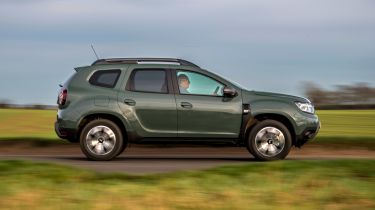Dacia Duster review - Engines, drive & performance (2018-2024)
No Dacia Duster is a ball of fire, but handling is safe, responsive and enjoyable
Very few SUVs – at any price – are geared towards thrilling their driver, and the Dacia Duster does little to quicken the pulse. Crucially, though, it offers barely less driving enjoyment, involvement or reward than many cars with far more intimidating price tags.
The Duster is quite light, which helps to make it feel nimble. This means it’s a lot more fun than you might expect. The electric steering doesn't take any strength to use but is a bit heavy in the diesel version, while plenty of grip from those meaty-looking tyres without as much kickback as before over bumps. The brakes impress, too – shedding speed with little fuss even when an emergency stop is required. A sports car driver will find little to get excited about, but few will find the Duster a chore to drive.
In spite of the lack of outright pace on offer, the Duster TCe 100 Bi-Fuel model we drove made up for it with a decent amount of composure on a variety of roads. It reacted well to broken-up road surfaces too, doing a good job of absorbing smaller potholes and imperfections. In corners, it feels secure enough, but there are noticeable amounts of body lean due to the tall suspension setup. Elsewhere, the steering is mostly accurate without much feel, but it’s well-weighted and easy to use at lower speeds making parking manoeuvres easy to complete.
The Duster is now far more refined than the previous model; there’s a noticeable drop in road and wind noise at a steady 60mph. Dacia says noise inside the car has been halved thanks to more sound deadening and thicker glass, amongst other fine detail changes. It's still fairly noisy compared with more expensive models like the Volkswagen T-Cross, however.
More reviews
Most Duster models get a six-speed manual gearbox, while the most powerful TCe 150 model is fitted with a six-speed automatic as standard. The manual is nice and light, and an easy clutch pedal makes the Duster effortless and simple to drive around town. The six-speed DCT dual-clutch automatic makes driving even more effortless, but it’s not worth upgrading to the most powerful model for this reason alone unless you absolutely need to.
Petrol engines
The 1.0-litre TCe 90 is offered across the range, producing 89bhp, and capable of 0-62mph in 13.1 seconds. A TCe 100 Bi-Fuel engine is also available, and uses the same engine tuned for a little more power, aside from the ability to run on LPG and petrol. Despite the added weight of the LPG tank, it still feels fairly brisk to drive with most of the power kicking in higher up the rev range. On the road, it feels a little quicker than the 15.1 second 0-62mph time suggests when running in petrol mode. Switch it into LPG mode and an audible click from the engine bay lets you know you’ve made the switch. When running on LPG, there's slightly more torque at lower revs, which makes the Duster slightly more flexible and easy to drive, but even with 0-62mph cut to 13.8 seconds, most drivers will struggle to notice the difference.
From Expression trim and upwards, a 1.3-litre turbocharged four-cylinder engine becomes available. This is more powerful, offering either 128bhp or 148bhp. In these models, 0-62mph takes either 10.6 or 9.7 seconds. Perhaps showing how far Dacia has come in a few years, this new turbocharged engine is shared with lots of cars, including the Nissan Qashqai and even the Mercedes A-Class.
Dacia Duster diesel engines
Dacia has offered the Duster with just one diesel option in the past, though it’s since been discontinued. The well-proven 1.5-litre dCi 115 was also found under the bonnet of Renault and Nissan models, and with 113bhp, it had enough to allow the Duster to accelerate from 0-62mph in 10.2 seconds. It feels well suited to towing and load-carrying, especially when fitted with optional four-wheel drive, which is exclusive to this engine. If this is a priority for you, you might have to consider buying a used diesel Duster.
A lack of much noise insulation in the Duster means it does sound a little rattly, not just when cold but any time it's left idling. There's also a rasp just as it gets going, which is a shame, as it's at the point that the punch kicks in that the engine is at its best. The 0-62mph time doesn't really do the engine justice because its pulling power and the Dacia's relatively light weight makes it feel quick enough.











